5. Setting up a Private Temple in Your Home

Note) This entry has a related video. See the YouTube link below.
My departed Jodo-shu Master would cite a Japanese proverb: “The heart seeks form, and form nourishes the heart.” After all, in Buddhism, it is taught that “Shiki-soku ze-kuu (色即是空: Matter is void, all is vanity),” that is, “Do not hold attachment to the outer appearance,” however a Buddhist statue nevertheless helps us to give our all. It is like recalling your family or friends: the way you remember them is perhaps different if you have a photograph in your hand than when you do not. In order to introduce the Buddhist practice to your daily life, let me demonstrate a simple and quick way to arrange a “form which nourishes your heart,” or how to set up a worship space.
- Step One
First of all, invite Amitabha. Taking a temple as an example, the center of the temple is “Hondo” (the main hall for worship). In turn, the center of the Hondo is “Honzon” (the main Buddhist image). The same applies to your home. Although the example below shows the Jodo-shu convention, the Amitabha image may be replaced with another Buddhist image depending upon the school you belong to.
In Japan, we have a “Butsudan” (a Japanese-style Buddhist home altar), at the uppermost center of which an Amitabha image is situated. The image may be a carved or cast statue or a hanging picture.
However, the Butsudan is not always necessary. Instead, you can use a small table, the top of a low bookcase, a sideboard, or any stand you have, and set a statue or a picture as in Fig. 1, in which a photograph of a wood statue is mounted in a frame. (The statue in the photograph in Fig. 1 is the Honzon of our temple, Rinkaian. The image file of this photograph is now downloadable from the Download page).
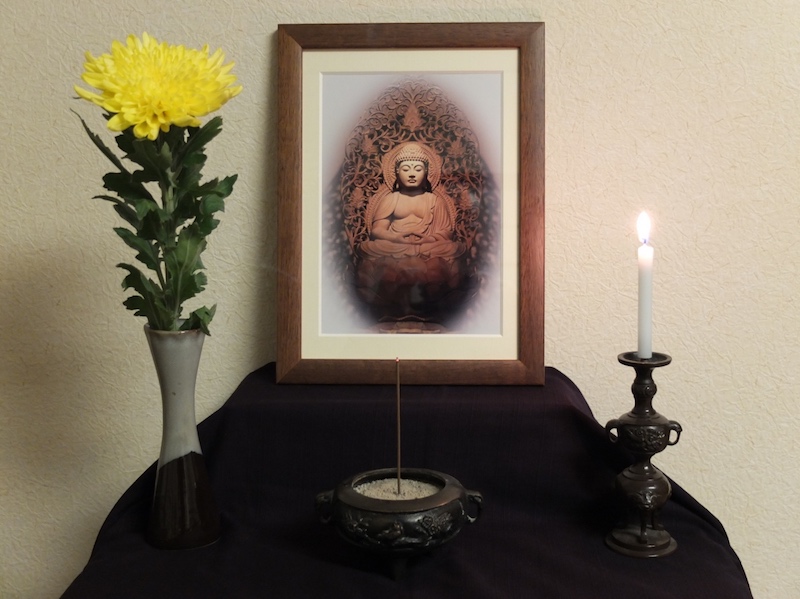 [Fig. 1]
After setting your Honzon, prepare Buddhist items for decorating the Honzon. There are three basic Buddhist items.
[Fig. 1]
After setting your Honzon, prepare Buddhist items for decorating the Honzon. There are three basic Buddhist items.
- Candles: Light a candle, which signifies the radiance of wisdom of Amitabha. The candle is usually put on the (your) right side.
- Censer: Powdered ash should be put in before setting it. Set it in the center in front of the Amitabha image. Burn an incense stick by the flame of the candle and insert it upright in the center of the censer to offer its fragrant scent to Amitabha.
- Flowers: Put flowers on the left side.
Although a pair of candles and a pair of flower vases are sometimes arranged, one candle and one vase will also do.
- Step Two
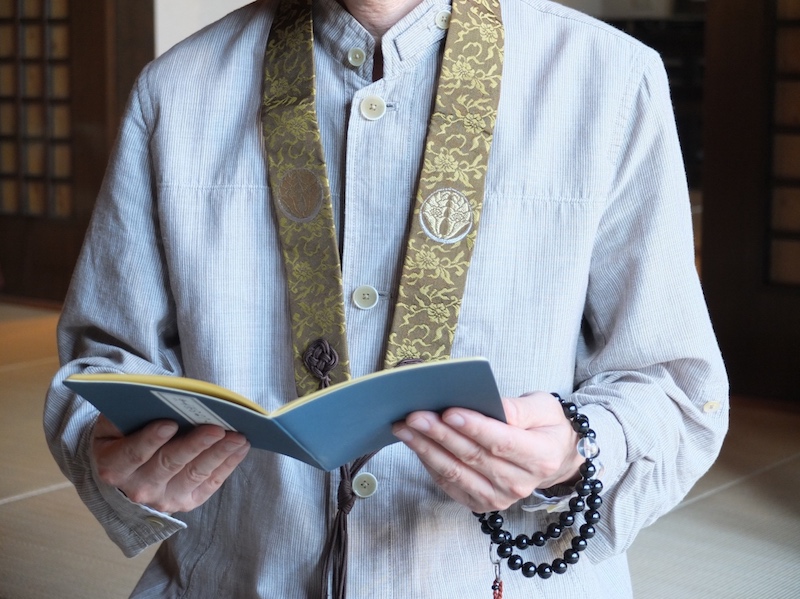 [Fig. 2(a)]
[Fig. 2(a)]
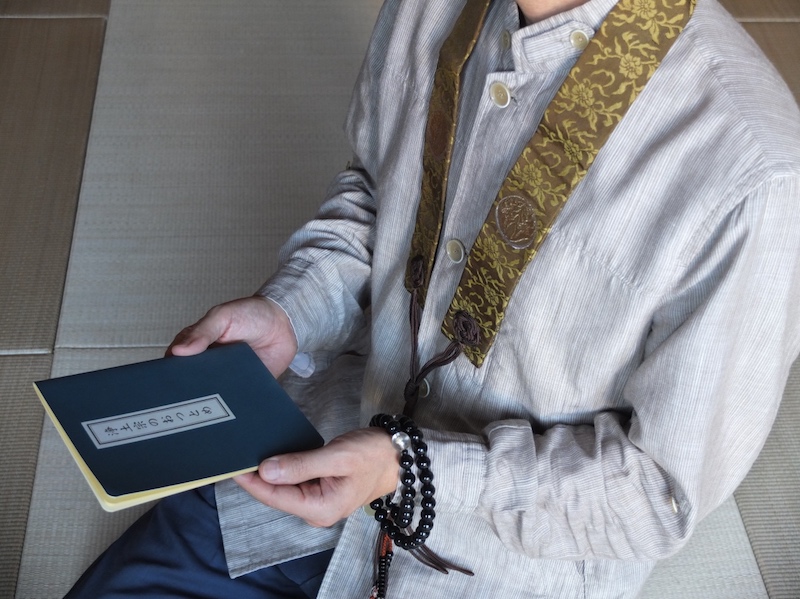 [Fig. 2(b)]
[Fig. 2(b)]
After Step One is finished, you can chant Nembutsu in a Gassho pose (i.e. with your hands joined) in front of the Honzon. Note that Honen Shonin taught that being devoted only to Nembutsu is enough, so even Step One is not absolutely necessary because we can chant Nembutsu without an Amitabha statue. Therefore, consider these steps as an environment facilitating the chanting of Nembutsu.
Now let’s prepare the Buddhist “gear” you put on.- Juzu (Beads/Buddhist rosary): This is originally for the purpose of counting Nembutsu: however, you can put it on even when you do not count Nembutsu.
Kesa (A Buddhist robe): This is a symbol of the Buddhist. In Jodo-shu, we generally use “Wa-gesa” (a simplified, ring-shaped Kesa), which is fitted around the neck as in Fig. 2. - Sutra text: This is required when sutras are chanted in addition to Nembutsu. You can download a PDF text of sutras from our website.
(Go to Download Page. See “Daily OTSUTOME,” or “Basic OTSUTOME” which is the English version of an excerpt from OTSUTOME).
Note) The juzu is hooked around your thumbs when you are in a Gassho pose. See Fig. 3.
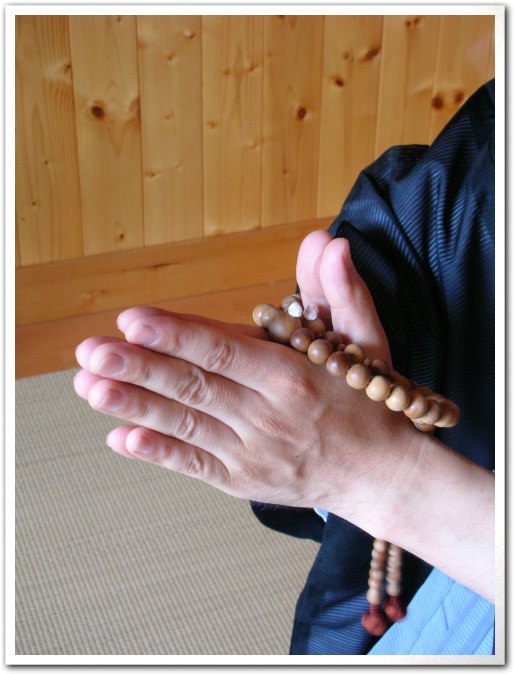
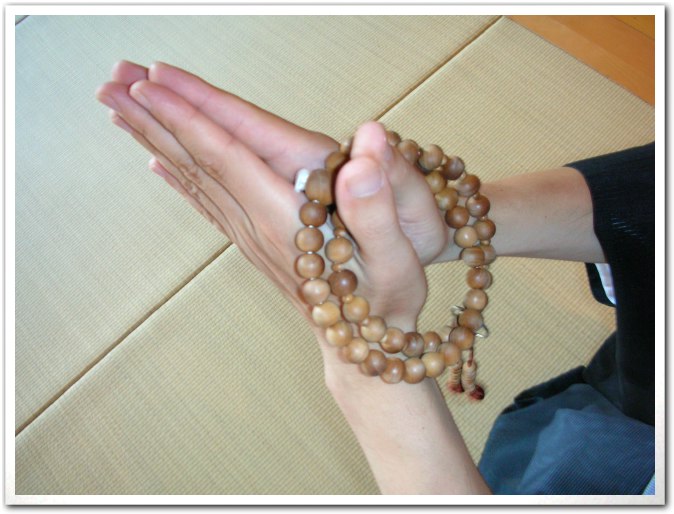 [Fig. 3]
[Fig. 3]
- Juzu (Beads/Buddhist rosary): This is originally for the purpose of counting Nembutsu: however, you can put it on even when you do not count Nembutsu.
- Step Three
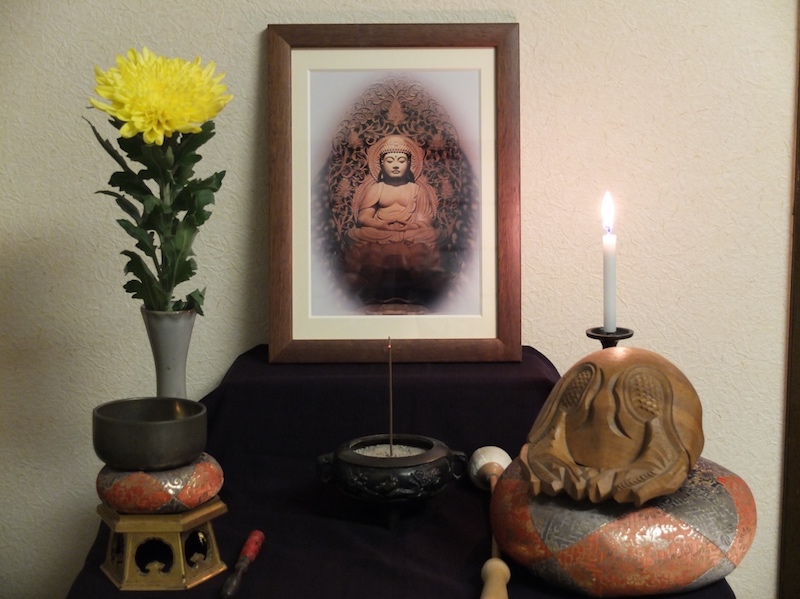 [Fig. 4]
When some people gather for Nembutsu or a Buddhist service, it is necessary to chant in unison. This is facilitated by “o-rin” (the bell on the left side in Fig. 4 on a cushion, with a stick beside the base) and “mokugyo” (a wooden percussion instrument shaped like a fish: In Fig. 4, on the left side, there is a mokugyo on a cushion accompanied by a stick with a soft ball at the tip). In some sutras, the o-rin and mokugyo are beaten at set times. In the near future I am planning to upload a sutra text making the timing of sounding the o-rin and mokugyo clear.
[Fig. 4]
When some people gather for Nembutsu or a Buddhist service, it is necessary to chant in unison. This is facilitated by “o-rin” (the bell on the left side in Fig. 4 on a cushion, with a stick beside the base) and “mokugyo” (a wooden percussion instrument shaped like a fish: In Fig. 4, on the left side, there is a mokugyo on a cushion accompanied by a stick with a soft ball at the tip). In some sutras, the o-rin and mokugyo are beaten at set times. In the near future I am planning to upload a sutra text making the timing of sounding the o-rin and mokugyo clear.
❖ ❖ ❖
I hope that small Nembutsu circles can be formed all over the world. The “private temple” demonstrated here can be set up by anyone according to one’s circumstances. You can chant alone at your private temple, or you can chant Nembutsu together with your friends. How about holding regular meetings for Buddhist services and book readings? Reading Jodo sutras and studying the words of Honen Shonin will help deepen your understanding of Nembutsu.
If there is a Jodo-shu priest nearby, he/she could help you or answer your questions; however, I suppose this is not always the case. Therefore, please e-mail me if you have any questions.
Note) The Buddhist items listed here are available via e-commerce sites like amazon.com (perhaps you know more sites than I), and there is also a Japanese website https://tokyotrad.com/ for such needs, with which I have contacted and confirmed that they sell these Buddhist items.
* Thanks to a comment by Scott Cantwell via Facebook, we have found their eBay Hangesa page.
* eBay page is sometimes changed: As of May 2022, this hangesa (=wagesa) seller page is available.
Demonstration of the Otsutome service with these settings on YouTube (Jodo Talk 6)
Jodo-shu Basic Manner at Your Home Altar (Jodo Talk 7)
Created: November 13, 2017 Updated: June 6, 2023
